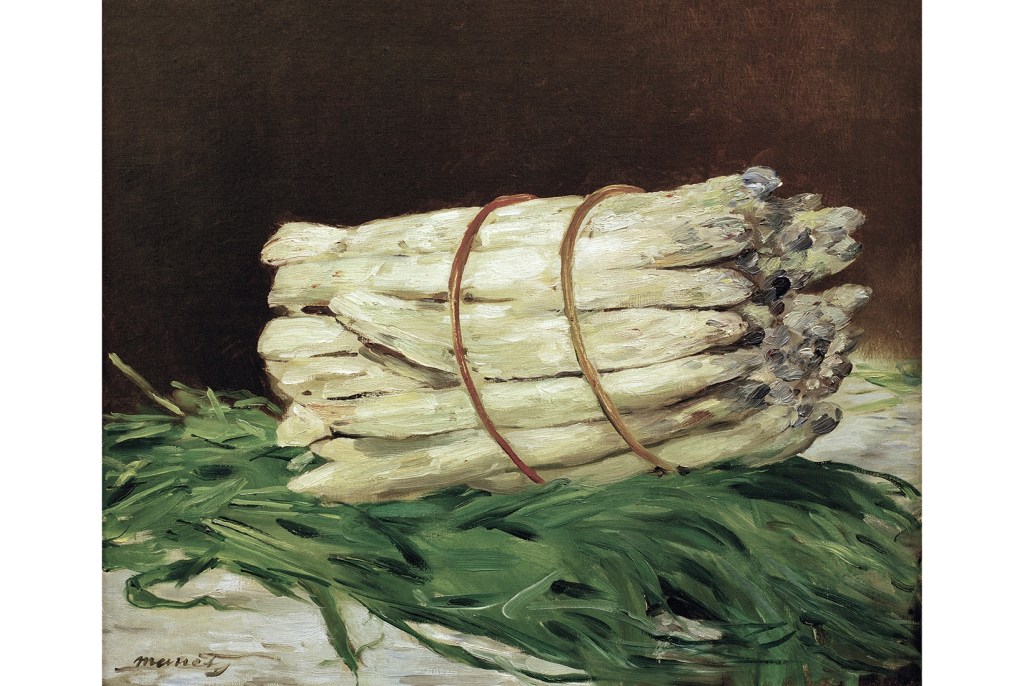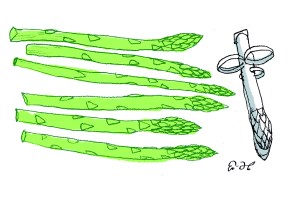Manet’s ‘Botte d’asperges’ are probably the most famous asparagus in the world. The artist painted the delicious white- and lilac-tinged spears for the collector Charles Ephrussi in 1880 before invoicing him for 800 francs. Ephrussi was so delighted with them that he paid Manet 1,000 instead, to which Manet responded by sending a second picture. ‘One appears to have escaped your bunch,’ the painter quipped in his accompanying note. The new canvas featured a single asparagus.
Manet was in the last decade of his life when he began sending small paintings of fruit and flowers to his friends. While Ephrussi received asparagus, the muse Méry Laurent got apples, and artist Berthe Morisot violets, like those Manet had included in his portrait of her in mourning. Each picture offered something lasting. I would have given you the real thing, Manet seems to say, but they’d only have rotted away.
There is nothing quite like asparagus. By the time you have your first bunch simmering in the pan you can be sure that it’s spring and that nothing, not even rain, can stop you from enjoying it. For artists, too, asparagus have proved utterly irresistible, the soft, paintbrush tips and stalks like stegosauri with their green-and-purple spikes lending interest to dozens of paintings besides Manet’s.
For the dark background of his ‘Botte d’asperges’, the Frenchman drew inspiration from the artists of the Dutch Golden Age, who were just as enamored of the vegetable as he was. The little-known Middelburg artist Adriaen Coorte (active 1683-1707) perhaps gloried in asparagus above any other. Typically working on paper mounted on panels measuring just 8-12in, Coorte produced a number of exquisite still lifes, most of which lay forgotten until the 20th century.
While his contemporaries celebrated profusion, painting extravagant spreads of food too abundant to eat, Coorte favored what was small and unpretentious. He found beauty in a handful of common medlars, in gooseberries from the market, in wild strawberries still trailing the vine. But most of all, he found profundity in asparagus.
Coorte painted it repeatedly, sometimes with strawberries, sometimes with redcurrants or cherries — he was by no means restricted by seasonal availability — to set off the greens. His beautifully lit study of asparagus with a butterfly glows on the salmon-pink wall of Kunsthaus Zürich. In the Rijksmuseum, Coorte’s asparagus are alone, huge, and cigar-like. Look closely and you might even say they were bombs in a futurist painting. One spear droops pitifully over the edge of the table. The whole bunch, in fact, looks perilously close to rolling to the floor. Coorte almost always pushed his composition to the very corner of the table or ledge, as if to symbolize the uncertainty of life.
In ancient Rome, and especially at Pompeii, asparagus was seen to be paradigmatic of the fertility of the countryside. Many wealthy homeowners had it depicted in their wall frescoes and mosaics. Asparagus grew so abundantly in the wild, as it still does in parts of Italy and Greece, that Pliny could complain of the wantonness of cultivating giant specimens. ‘The gluttony!’ he exclaimed, on hearing of asparagus weighing three pounds.
Asparagus may be found dripping in shrimp butter or hollandaise in some of the nicest restaurants today, but historically, it has often been celebrated as a humble vegetable. On the table between Christ and the two disciples in Giovanni Battista Piazzetta’s ‘Supper at Emmaus’ (1720), where we would usually see bread, we find a large plate of glowing white asparagus. The succulent spears, by no means intended to denote luxury, come as quite a surprise to those of us used to seeing them on menus for $28.
Artists have just occasionally explored asparagus’s phallic potential. Max Ernst’s sculpture ‘Les Asperges de la Lune’, designed in 1935, plays on the fact that the French for asparagus — seen as an aphrodisiac for centuries — can also mean penis. Ernst’s giant erect asparagus may equally evoke the truly bizarre way in which real asparagus grow. Visit a farm and you’ll find hundreds of individual spears poking their heads through the soil like members of a miniature Theban army.
Even when cooked, asparagus are, it must be said, decidedly odd-looking. In shape and tone they challenge the palette in much the same way as they do the palate. It is perhaps not surprising that Proust took such an interest in them. Inspired, some believe, by his friend Charles Ephrussi, Proust had Elstir, the artist, produce a painting like Manet’s in À la recherche du temps perdu and offer to sell it to the Duc de Guermantes. ‘Trois cents francs, une botte d’asperges!’ exclaims the Duke. You can bet it was worth every centime.
This article was originally published in The Spectator’s UK magazine. Subscribe to the World edition here.


















